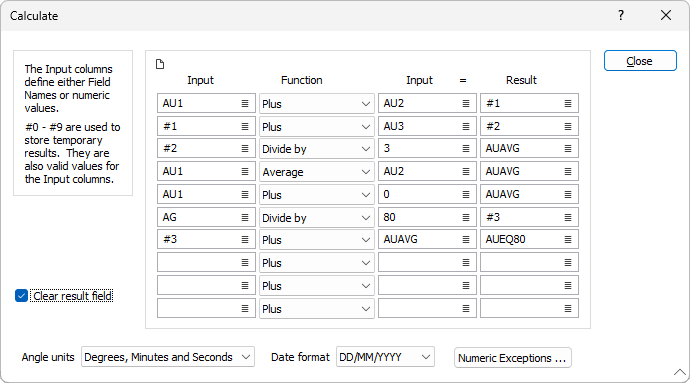Field Calculate

This option is also available on the File tab, in the Edit Data group and on the Lookup Table Editor tab for Lookup Tables. Select the file you want to perform a calculation on.
To use dynamic expressions to calculate new field values from existing field values, see: Calculate (Expression)
File
Specify the Name and Type of the Source file and optionally apply a filter.
These inputs are not available when the Expression Calculate form is opened from the File Editor.
Clear Result field
Selecting this option will ensure that any contents in the Result field will be cleared before new data is written there.
Overwrite Result field
Select this option to overwrite the existing contents of the Result field. When you clear this option, only those Result fields with blank values will be recalculated.
Numeric Exceptions
(Optionally) Use the Numeric Exceptions group to control the way that non-numeric values are handled. Non-numeric values include characters, blanks, and values preceded by a less than sign (<).
Angle units
The Angle units selection is applied when at least one Angle function has been selected in the list of Functions. The default format is Degrees and Decimal Degrees. A Degrees, Minutes and Seconds option can also be selected.
Date format
The Date format selection is applied when at least one Date function has been selected in the list of Functions. Select the format that will be used when writing a date to the Result field:
| DD/MM/YYYY | e.g. 26/5/2023 |
| MM/DD/YYYY | e.g. 5/26/2023 |
| DD MMM YYYY | e.g. 26 MAY 2023 |
| YYYYMMDD | e.g. 20230526 |
Calculations
Field calculations are setup in the rows and columns of the table in the Calculate form. Use the buttons on the local toolbar to Manage the rows in the list.

The results of each step can be used in the next step, by storing the results in temporary fields. See: Using temporary fields during calculations
- Using Calculate is the only way to make a straight copy of numerical data from one field to another. To do so, just add zero to the field you want to copy, then write the result to the destination field.
- You can use the Calculate functions, for example, to convert between Strike and Dip direction values, cut assays to a defined value, and total the values down a hole while the consecutive values of any variable remain unchanged.
Input (Primary)
Specify a primary Input value (or double-click) to select the name of the field containing the data that will used in the calculation. Inputs to the calculation are either numeric values or data contained in fields. #0 to #9 are used to store temporary results and can themselves be specified as inputs.
Function
Select a Function from the drop-down list. In addition to common maths functions, Functions applicable to the management of earth science data are provided.
Input (Secondary)
If applicable, specify a secondary Input. This will be passed as the second argument to the function you have selected.
Result
In the Result column, double-click to select the name of the field where the result of the operation will be stored. A temporary field is indicated by #0 to #9. The final result must be an existing field in the file.
Forms
Click the Forms button to select and open a saved form set, or if a form set has been loaded, save the current form set
Run
Finally, click Run to begin the calculation. This may take some time depending on the complexity of the calculation. A progress indicator will appear in the status bar at the bottom of the page.